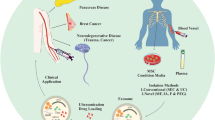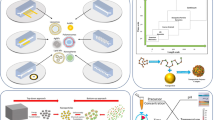Abstract
The contraction–expansion array (CEA) channel device utilizes hydrodynamic effects, which include inertial lift forces and Dean drag forces, to manipulate particles at a very high throughput and without external forces. The equilibrium position for the particles in a CEA channel can be affected by both the particle size and the flow streamlines. Here, four focusing patterns with different particle sizes were investigated, and the force mechanism was analyzed. We present four CEA channels with different aspect ratios (\(\varphi\)) and expansion and contraction angles (\({\alpha _{\text{e}}}\) and \({\alpha _{\text{c}}}\)) based on the process of changing the particle equilibrium positions. The results show that 20 µm particles migrated to the side of the channel as the aspect ratio \((\varphi )\) increased, and the smaller expansion and contraction angles were conducive to the particle focusing. The Circle channel possesses the best focusing effect. Finally, the microfluidic system was applied for the separation of plasma, RBCs and NCI-H1299 cancer cells from blood with high efficiency and purity.













Similar content being viewed by others
References
Amini H, Sollier E, Masaeli M, Yu X, Ganapathysubramanian B, Stone HA, Carlo DD (2013) Engineering fluid flow using sequenced microstructures. Nat Commun 4:1826
Amini H, Lee W, Di CD (2014) Inertial microfluidic physics. Lab Chip 14:2739–2761
Antfolk M, Muller PB, Augustsson P, Bruus H, Laurell T (2014) Focusing of sub-micrometer particles and bacteria enabled by two-dimensional acoustophoresis. Lab Chip 14:2791–2799
Asmolov ES (1999) The inertial lift on a spherical particle in a plane Poiseuille flow at large channel Reynolds number. J Fluid Mech 381:63–87
Berger SA, Talbot L, Yao LS (1983) Flow in curved pipes. Ann Rev Fluid Mech 15:461–512
Breadmore MC et al (2011) Recent advances in enhancing the sensitivity of electrophoresis and electrochromatography in capillaries and microchips (2012–2014). Electrophoresis 32:127–148
Butement JT et al (2016) Integrated optical waveguides and inertial focussing microfluidics in silica for microflow cytometry applications. J Micromech Microeng. https://doi.org/10.1088/0960-1317/26/10/105004
Carlo DD, Edd JF, Humphry KJ, Stone HA, Toner M (2009) Particle segregation and dynamics in confined flows. Phys Rev Lett 102:094503
Chao L, Xue C, Chen X, Lei S, Yu T, Hu G (2015) Size-based separation of particles and cells utilizing viscoelastic effects in straight microchannels. Anal Chem 87:6041–6048
Cherukat P, Mclaughlin JB (1994) The inertial lift on a rigid sphere in a linear shear flow field near a flat wall. J Fluid Mech 263:1–18
Choi YS, Seo KW, Lee SJ (2011) Lateral and cross-lateral focusing of spherical particles in a square microchannel. Lab Chip 11:460–465
Di CD (2009) Inertial microfluidics. Lab Chip 9:3038
Dinler A, Okumus I (2018) Inertial particle separation in curved networks: a numerical study. Chem Eng Sci 182:119–131
Drew DA (1978) The force on a small sphere in slow viscous flow. J Fluid Mech 88:393–400
Hansson J, Karlsson JM, Haraldsson T, Wijngaart WVD, Russom A (2011) Inertial particle focusing in parallel microfluidic channels for high-throughput filtration. In: Solid-state sensors, actuators and microsystems conference, 2011, pp 1777–1780
Hu G, Liu C, Sun J, Jiang X (2012) Size-dependent cell separation and enrichment using double spiral microchannels. In: Aps meeting
Jimenez M, Miller B, Bridle HL (2017) Efficient separation of small microparticles at high flowrates using spiral channels: application to waterborne pathogens. Chem Eng Sci 157:247–254. https://doi.org/10.1016/j.ces.2015.08.042
Karimi A, Yazdi S, Ardekani AM (2013) Hydrodynamic mechanisms of cell particle trapping in microfluidics. Biomicrofluidics 7:205
La M, Park SJ, Kim HW, Park JJ, Ahn KT, Ryew SM, Dong SK (2013) A centrifugal force-based serpentine micromixer (CSM) on a plastic lab-on-a-disk for biochemical assays. Microfluid Nanofluid 15:87–98
Lee MG, Choi S, Park JK (2009) Rapid laminating mixer using a contraction-expansion array microchannel. Appl Phys Lett 95:6247
Liu C, Hu G, Jiang X, Sun J (2015) Inertial focusing of spherical particles in rectangular microchannels over a wide range of Reynolds numbers. Lab Chip 15:1168
Nam J, Lim H, Kim D, Jung H, Shin S (2012) Continuous separation of microparticles in a microfluidic channel via the elasto-inertial effect of non-Newtonian fluid. Lab Chip 12:1347
Oakey J Jr, Arellano AR, Di E, Graves CD, Toner SW M (2010) Particle focusing in staged inertial microfluidic devices for flow cytometry. Anal Chem 82:3862
Özbey A, Karimzadehkhouei M, Bayrak Ö, Koşar A (2018) Inertial focusing of microparticles in curvilinear microchannels with different curvature angles. Microfluid Nanofluid 22:62
Schaap A, Dumon J, Toonder JD (2016) Sorting algal cells by morphology in spiral microchannels using inertial microfluidics. Microfluid Nanofluid 20:125
Segré G, Silberberg A (1961) Radial particle displacements in poiseuille flow of suspensions. Nature 189:209–210
Syed MS, Rafeie M, Vandamme D, Asadnia M, Henderson R, Taylor RA, Warkiani ME (2017) Selective separation of microalgae cells using inertial microfluidics. Bioresour Technol 252:91–99
Toner M, Irimia D (2005) Blood-on-a-chip. Annu Rev Biomed Eng 7:77
Warkiani ME, Tay AK, Khoo BL, Xiaofeng X, Han J, Lim CT (2015) Malaria detection using inertial microfluidics. Lab Chip 15:1101
Warkiani ME, Khoo BL, Wu L, Tay AKP, Bhagat AAS, Han J, Lim CT (2016) Ultra-fast, label-free isolation of circulating tumor cells from blood using spiral microfluidics. Nat Protoc 11:134
Wu L, Guan G, Hou HW, Bhagat AAS, Han J (2012) Separation of leukocytes from blood using spiral channel with trapezoid cross-section. Anal Chem 84:9324–9331
Wu Z, Chen Y, Wang M, Chung AJ (2015) Continuous inertial microparticle and blood cell separation in straight channels with local microstructures. Lab Chip 16:532–542
Xiang N, Yi H, Chen K, Sun D, Jiang D, Dai Q, Ni Z (2013) High-throughput inertial particle focusing in a curved microchannel: insights into the flow-rate regulation mechanism and process model. Biomicrofluidics 7:021501
Zhang J, Li M, Li WH, Alici G (2013) Inertial focusing in a straight channel with asymmetrical expansion–contraction cavity arrays using two secondary flows. J Micromech Microeng 23:085023
Zhang J, Li W, Ming L, Alici G, Nguyen NT (2014a) Particle inertial focusing and its mechanism in a serpentine microchannel. Microfluid Nanofluid 17:305–316
Zhang J, Sheng Y, Alici G, Nguyen NT, Li W (2014b) Real-time control of inertial focusing in microfluidics using dielectrophoresis (DEP). RSC Adv 4:62076–62085
Zhang J, Sheng Y, Li W, Alici G, Nguyen NT (2014c) High throughput extraction of plasma using a secondary flow-aided inertial microfluidic device. RSC Adv 4:33149–33159
Zhang J, Sheng Y, Sluyter R, Li W, Alici G, Nguyen N-T (2014d) Inertial particle separation by differential equilibrium positions in a symmetrical serpentine micro-channel. Sci Rep 4:4527
Zhang J, Yan S, Yuan D, Alici G, Nguyen NT, Ebrahimi WM, Li W (2015) Fundamentals and applications of inertial microfluidics: a review. Lab Chip 16:10–34
Zhang J et al (2018) Tunable particle separation in a hybrid dielectrophoresis (DEP)-inertial microfluidic device. Sens Actuators B Chem 267:14–25
Zhu GP, Hejiazan M, Huang X, Nguyen NT (2014) Magnetophoresis of diamagnetic microparticles in a weak magnetic field. Lab Chip 14:4609–4615
Acknowledgements
This work is supported by the Natural Science Foundation of China (21606164). The authors want to acknowledge the channels’ fabrication support from Southeast University, China.
Author information
Authors and Affiliations
Corresponding author
Additional information
Publisher’s Note
Springer Nature remains neutral with regard to jurisdictional claims in published maps and institutional affiliations.
Rights and permissions
About this article
Cite this article
Liu, L., Han, L., Shi, X. et al. Hydrodynamic separation by changing equilibrium positions in contraction–expansion array channels. Microfluid Nanofluid 23, 52 (2019). https://doi.org/10.1007/s10404-019-2219-9
Received:
Accepted:
Published:
DOI: https://doi.org/10.1007/s10404-019-2219-9




